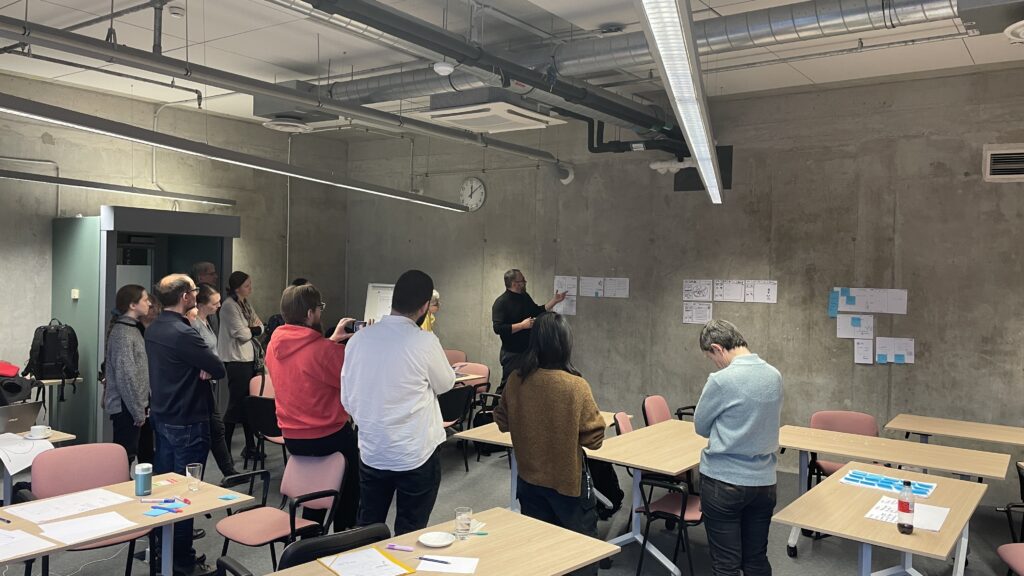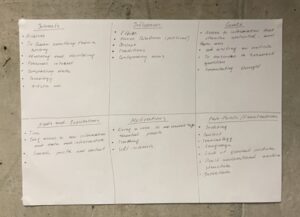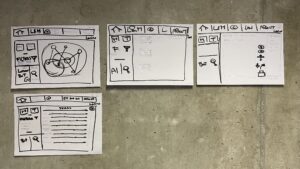 News
News
DIGHT-Net Workshop Report: Building the Digital Archive of a Scholar, 25-27 February 2025
March 14, 2025

From February 25 to 27 2025, the DIGHT-Net workshop “Building the Digital Archive of a Scholar” took place at Tallinn University. Through expert lectures, discussions and a hands-on collaborative interface design method, the attendants worked to solidify the first ideas of how to structure and design the digital archive of Juri Lotman and Zara Mints.
After Prof. Marek Tamm opened the workshop by introducing its programme and the DIGHT-Net project, Prof. Charles Jeurgens (University of Amsterdam) discussed the impact of datafication on archival studies. In doing so, he stressed the importance of viewing archival data within its context, and how new contexts, such as through digitisation, can therefore generate new meanings. Following up this insightful talk, Andres Uueni (Estonian Academy of Art) discussed strategies for the preservation of digital cultural heritage, highlighting various necessities and pitfalls from the perspective of both creators and users. His talk inspired a lively discussion and reflections on the project objective of ‘twinning’ the archive in Tallinn with Umberto Eco’s archive at the University of Bologna. These considerations were carried forward in the remainder of the workshop programme.
Thereafter, Lu Chen (Aalto University) provided an inspiring example of digital archive design and functionalities by discussing the Nokia Design Archive. She exemplified how to bring together a range of different archival materials in interactive, innovative ways. While highlighting the potentialities of data visualisations that digitisation brings, she also stressed that visualisations are not neutral but carry meaning and function. Providing insight into the intricacies of another archive’s digitisation process, Prof. Francesco Mazzucchelli (University of Bologna) continued with a talk about the development of the hybrid personal archive of Umberto Eco. Francesco clarified the importance of thinking through the material that should ideally be digitised, and how these could serve to connect the scholarly archive of Eco with that of Lotman and Mints. In doing so, he argued that these choices should be informed by a conceptualisation of what the archive is intended to be and according to envisioned future opportunities in terms of integration and interaction with other archives.
The following day, the program continued with several more talks that functioned to thoroughly introduce the attendees into essential topics for the afternoon’s hands-on workshop. Prof. Marek Tamm did so by providing an overview of the envisioned core functionalities and desired innovative features for the digital archive of Lotman and Mints, as well as by highlighting preliminary benefits and impacts of the project. Afterwards, Merit Maran (Tallinn University) introduced the archive’s contents, information systems and digitisation processes. She for instance highlighted the challenges of integrating into one coherently systematised digital archive the respective materials of both Tallinn University and the Tartu University Library, and explained the many different types of documents that the archives contain. Yan Asadchy (TLU) thereafter gave a talk on interfaces and approaches to large collections. By showing a myriad of different types of digital interfaces and their functionalities, Yan inspired the participants to think about possibilities and best practices for the design of the Lotman and Mints archive, thus paving the way for the afternoon’s hands-on workshop.
After a short visit to the Juri Lotman Semiotics Repository, the hands-on part of the programme commenced. In this workshop, researchers, archivists, historians, and semioticians came together to explore new ways of interacting with digital archives. Using a design sprint-inspired approach, participants worked in small teams to identify user challenges, analyse existing collections, and prototype innovative solutions. Kicking off this part of the programme, Yan Asadchy, the workshop’s host, and Prof. Marek Tamm asked participants to specify their professional experience and then split into three teams that cover a wide range of expertise. This ensured a fertile ground for new ideas and insights that participants were expected to share throughout the workshop.
 The teams first completed an ice-breaking exercise that involved drawing and doodling. This exercise was a great way to release tension among the attendees and unlock their creative potential. Following that, the groups started their brainstorming session, first being asked to think through the possible challenges users can face when engaging with digital collections. This task, combined with the diverse structure of teams, was intended to reveal the potential use cases and struggles some individuals can have while interacting with large collections. The exercise concluded with groups presenting and discussing their insights, which were solidified into potential users – a collective representation of specific users based on their interests, influences, goals, deeds, expectations, motivations, and pain points.
The teams first completed an ice-breaking exercise that involved drawing and doodling. This exercise was a great way to release tension among the attendees and unlock their creative potential. Following that, the groups started their brainstorming session, first being asked to think through the possible challenges users can face when engaging with digital collections. This task, combined with the diverse structure of teams, was intended to reveal the potential use cases and struggles some individuals can have while interacting with large collections. The exercise concluded with groups presenting and discussing their insights, which were solidified into potential users – a collective representation of specific users based on their interests, influences, goals, deeds, expectations, motivations, and pain points.
Example matrix of interests, influences, goals, deeds, expectations, motivations, and pain points. Photo: Yan Asadchy
Afterwards, the groups commenced with mapping out the journeys of potential users of the archives. Through this narrative assignment, they integrated the identified challenges and potentials of the archive into more coherent ideas. The outcomes of this exercise were more specific stories that could be experienced by individuals engaging with the archives and large collections. By consolidating the experiences in a more personal and tangible way, they drew on empathy to propose solutions.
The last session of the day began with sketching the user journeys and sequences of screens that individuals would encounter when working with the interface of the large collection. In this exercise, groups closely followed their user stories and drew inspiration from other interfaces they encountered in their professional experience. This ensured that their proposed solutions addressed the pain points of future users. The day concluded by publicly sharing ideas and experiences, reviewing each other’s work, and finding similarities and dissimilarities. Participants were also encouraged to vote on the solutions thought of by the other teams which they thought would improve their approach.
The last day of the workshop started by reviewing the results of the previous session and identifying the gaps that were not addressed. The participants improved and finalised their sketches in this exercise, considering the voting results and feedback received the day before. After a small break, the teams resumed the workshop and focussed on developing higher fidelity mock-ups of their envisioned  interface. By drawing out the different frames of the digital archive’s potential features, the participants were stimulated to expand and think through their conceptualisations. Using a larger canvas, pens, markers, and other appliances, participants paid more attention to the auxiliary functions of the future interface. They considered tangent scenarios and requirements such as the registration of accounts, advanced search features, downloading, and sharing the data. After a final discussion, the workshop was then concluded. The interface prototypes developed by the participants will provide fruitful grounds for further designing the prospective archive of Juri Lotman and Zara Mints.
interface. By drawing out the different frames of the digital archive’s potential features, the participants were stimulated to expand and think through their conceptualisations. Using a larger canvas, pens, markers, and other appliances, participants paid more attention to the auxiliary functions of the future interface. They considered tangent scenarios and requirements such as the registration of accounts, advanced search features, downloading, and sharing the data. After a final discussion, the workshop was then concluded. The interface prototypes developed by the participants will provide fruitful grounds for further designing the prospective archive of Juri Lotman and Zara Mints.
Example of the higher fidelity prototype of the interface. Photo: Yan Asadchy
Yan Asadchy & Marjolein Uittenbogaard
